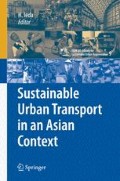Abstract
Asia is the most populated region in the world. The Asian economy has been growing for more than 50 years after the war with “the flying geese pattern” and oriented by market and export. The Asian continent and the surrounding archipelagos were connected by sea routes which have been expanding since the early civilizations in Asia. Asia formed a solid network over Asia through sea and river routes connecting port cities located at river mouths from the medieval age. Asian port cities were prosperous and played an important role as cultural and trade hubs to exchange cultural and trade powers from the continent and from the world outside Asia. The port cities played a critical role in connecting the inland civilization and the overseas civilization. Such historical path formed the current location of Asian megacities. Asia is now experiencing “rapid urbanization” and “rapid aging society” four times faster than those experienced in western countries. Besides, high population growth in flood prone areas will continue so that a higher risk will emerge in coastal port cities in Asia together with the risks associated with global climate changes. Therefore, Asian megacities are facing uncountable problems and challenges in all aspects of urban governance and management.
References
ADB 1997: Emerging Asia—Changes and Challenges.
ADB 2007: ADB Key Indicators.
ADB 2008: Working Paper Series on Regional Economic Integration No. 14, M. Kawai & G. Wignaraja.
IMF 2006: Direction of Trade Statistics (June 2006).
Ishii, N.2003: Chouki Keizai Hatten no Jisshou Bunseki, Nihon Keizai Shinbunsha (in Japanese).
OECD 1995: Monitoring the World Economy 1820–1992, OECD Development Center.
OFDA/CRED: International Disaster Database: http://www.cred.be/ downloaded on October 20, 2007.
UN Population Division 2005: World Population Prospects and World Urbanization Prospects, the 2005 Revision Population Database.
UN Population Division 2006: the 2006 Revision Population Database.
UN Population Division 2007: the 2007 Revision Population Database: http://esa.un.org/unup/ downloaded on March 08, 2008.
WDI 2006: World Bank Development Indicators.
Author information
Authors and Affiliations
Editor information
Editors and Affiliations
Rights and permissions
Copyright information
© 2010 Springer-Verlag Berlin Heidelberg
About this chapter
Cite this chapter
Ieda, H. (2010). Growing Economies and Cities in Asia: From Comparative and Historical Viewpoints. In: Ieda, H. (eds) Sustainable Urban Transport in an Asian Context. cSUR-UT Series: Library for Sustainable Urban Regeneration, vol 9. Springer, Tokyo. https://doi.org/10.1007/978-4-431-93954-2_2
Download citation
DOI: https://doi.org/10.1007/978-4-431-93954-2_2
Publisher Name: Springer, Tokyo
Print ISBN: 978-4-431-93953-5
Online ISBN: 978-4-431-93954-2
eBook Packages: Earth and Environmental ScienceEarth and Environmental Science (R0)

